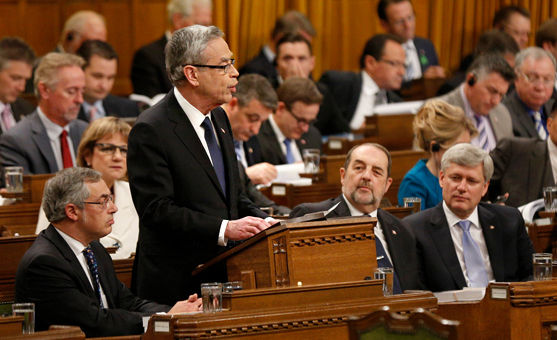By now, you’ve no doubt heard all about the increased contribution room clients have available in their Tax Free Savings Accounts (TFSAs), and the massage given to Registered Retirement Income Fund (RRIF) withdrawal rules unveiled in Finance Minister, Joe Oliver’s Economic Action Plan 2015. Both measures will clearly impact clients in different ways, but the list of features proposed in this year’s federal budget is more extensive, both for clients, and the industry alike.
Both measures will clearly impact clients in different ways, but the list of features proposed in this year’s federal budget is more extensive, both for clients, and the industry alike.
Buried deep in Oliver’s first budget, is an element of support for the country’s insurance advisors who compete with banks in making certain products available to clients. The changes are intended to consolidate consumer protection provisions contained in the Bank Act, to create a financial consumer code, under the Financial Consumer Agency of Canada.
At a glance, the change does not affect insurance players in the industry directly, except that it includes “expanded prohibitions on certain business practices, including high-pressure sales situations.” The budget also calls for cooling-off periods for a greater range of products sold by banks.
Practical considerations
Tabled in the House of Commons on April 21, 2015, the federal budget also contains a fair number of practical considerations – for business owner clients, for seniors, for those managing registered disability accounts on behalf of another, and a number of measures for families, as well.
Farmers and fishing operators also get a nod, veterans’ disability benefits are expanded somewhat, and clients hoping to guide their offspring more effectively through the Canada Student Loan program, may also get some relief from newly-relaxed rules.
Although Tax Free Savings Account contributions aren’t quite doubled as promised, the Finance Minister’s tabled documents increase the amount Canadians can contribute each year, from the current $5,500, to $10,000, effective as of January 1, 2015.
As of now, those who’ve made no contributions to their TFSA will have $41,000 worth of space available, up from $36,500 if the budget is not passed.
Although earlier rules allow indexing for inflation on the original $5,000 limit, proposed changes remove this provision: “In combination with other registered savings plans, a $10,000 TFSA annual contribution limit will allow most Canadians to save a significant proportion of their annual incomes in a tax-efficient manner. In this context, the annual limit will not be indexed to inflation.”
Although the TFSA limit increase is retroactive to January 1, 2015, and although the Canada Revenue Agency will administer and respect the increased amounts based on this budget announcement, some experts recommend exercising caution in making maximum contributions until the budget is confirmed by legislation.
This measure will help ensure that more students can pursue short duration post-secondary programs that focus on practical skills and provide a quick transition from education to employment.
The TFSA announcement explicitly discusses the benefit of an increased contribution limit for seniors – those most likely to be negatively impacted by low interest rates, and potential claw-backs to income-tested benefits.
Other provisions for seniors notably include a proposal to reduce the minimum amounts seniors must withdraw from their Registered Retirement Income Funds (RRIFs) each year. Although the age seniors must begin liquidating RRIFs is not adjusted, the yearly amounts seniors must withdraw have been reduced.
Currently, seniors must start withdrawing at least 7.38 per cent of their total savings from these registered accounts at age 71, increasing to 20 per cent of the remaining balance when they reach age 94. Under the new schedule, withdrawals begin at a lower amount – seniors must withdraw 5.28 per cent in the year they begin withdrawals. Beginning in the 2015 tax year, withdrawals of 7.38 per cent won’t be mandatory until age 82, effectively increasing the amount clients can maintain in their accounts.
For those experiencing difficulty gaining access to their home, or being mobile and functional within it, meanwhile, the budget also introduces a new Home Accessibility Tax Credit for seniors and those with disabilities.
Similar to temporary home renovation credits introduced in the past, the permanent measure is a proposed 15 per cent, non-refundable income tax credit which can be applied against home renovation costs, up to $10,000.
For seniors and families alike, those caring for gravely ill and dying family members may also avail themselves of Employment Insurance (EI) Compassionate Care Benefits, extended from six weeks to six months under the proposed plan.
For business owners
Most notable may be the budget’s pledge to reduce the small business tax rate from 11 per cent to nine per cent by 2019.
More immediately, small employers who must remit payroll taxes and source deductions worth less than $1,000, may now be able to remit quarterly. Until now, new employers were required to remit payroll taxes and premiums each month for at least one year.
In combination with tax credits announced in late 2014, Employment Insurance premiums may also be reduced for businesses, in a lead up to reform of the EI program’s calculations, proposed for 2017.
For farmers and fishing business owners who’ve built equity in their business, the budget also increases the Lifetime Capital Gains exemption to $1-million, up from $813,600 ($800,000 with an adjustment for inflation, introduced in 2014).
Manufacturing businesses, meanwhile, will benefit from the reintroduction of an accelerated capital cost allowance (CCA), to replace the straight-line depreciation rate (50 percent), introduced in 2007, which expires in 2015. The plan allows manufacturers with eligible assets acquired after 2015, but before 2026, to write off those investments at a rate of 50 per cent, on a declining balance basis. Budget documents say the move will help manufacturers plan larger projects as well, where investment may not be completed until several years after an investment decision is made, or in cases where longer-term investment requires multiple phases for implementation.
In addition to the TFSA increases, new provisions include support for would-be post-secondary students from lower and middle-income families.
Although the budget does not provide additional funding for grants, eligibility for low and middle-income Canada Student Grants will be expanded to allow those interested in shorter-duration programs to apply.
“This measure will help ensure that more students can pursue short duration post-secondary programs that focus on practical skills and provide a quick transition from education to employment.”
Beginning in 2016, the grants will be made available to low and middle-income students enrolled in educational programs of at least 34 weeks. (Currently, students must be enrolled in programs of at least 60 weeks to qualify.) The expansion will reportedly help approximately 42,000 additional students each year.
The budget also proposes to reduce parental contribution expectations, by modifying the needs assessment process that is currently part of the Canada Student Loans Program.
Finally, the budget extends pilot efforts like the Employment Insurance Working While On Claim project, intended to remove disincentives (reduced EI payments) to accepting work while on assistance, extending the project until August 2016.
Those born outside of Canada may also benefit from an influx of $35-million over five years, to make permanent the Foreign Credential Recognition Loans pilot project, introduced in 2011. The project provides loans to foreign-trained individuals, to help cover credentialing costs.
Other provisions
The budget contains a number of smaller promises for industry and clients alike, as well.
Those working with educators to advance the industry’s interests, may wish to pay attention to the budget’s sections promising help to train “the workforce of tomorrow.”
In particular, the budget promises a one-time investment of $65-million to businesses and industry associations who work with willing post-secondary institutions “to better align curricula” with employer needs.
In charitable planning, the budget proposes to extend existing capital gains exemptions on the donation of securities, to the sale of private shares and real estate as well, when sale proceeds are donated within 30 days. The changes also allow charities to invest in limited partnerships going forward, as well.
Disabled veterans should consult tax professionals after this announcement – the budget confirms funding to create a new tax-free Family Caregiver Relief Benefit for seriously disabled veterans – those requiring daily assistance from an informal caregiver, and expands access to impairment allowances.
And finally, measures put in place to allow qualifying family members to hold and manage a Registered Disability Savings Plan on behalf of those who cannot enter into a contract themselves, will be extended until the end of 2018 while jurisdictions continue to develop solutions to bridge legal gaps related to competency and ownership.







